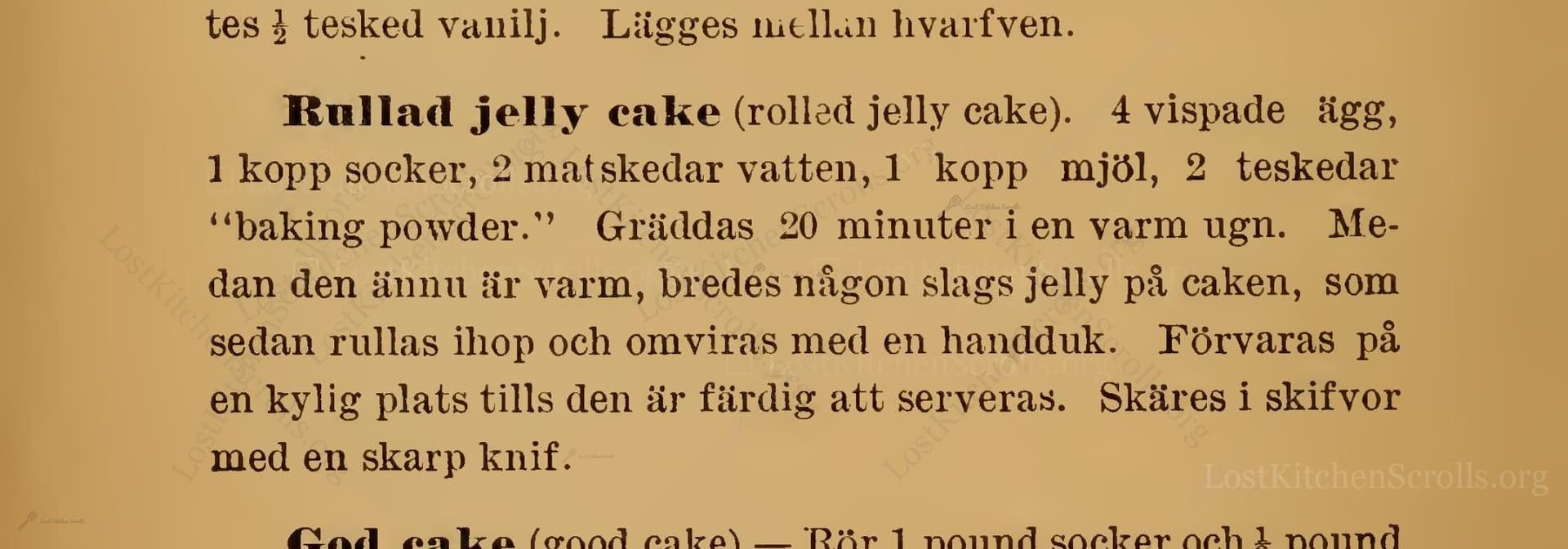
Rullad Jelly Cake (Rolled Jelly Cake)
"— 4 vispade ägg, 1 kopp socker, 2 matskedar vatten, 1 kopp mjöl, 2 teskedar “baking powder.” Gräddas 20 minuter i en varm ugn. Medan den ännu är varm, bredes någon slags jelly på caken, som sedan rullas ihop och omviras med en handduk. Förvaras på en kylig plats tills den är färdig att serveras. Skäres i skifvor med en skarp knif."
English Translation
"— 4 beaten eggs, 1 cup sugar, 2 tablespoons water, 1 cup flour, 2 teaspoons baking powder. Bake for 20 minutes in a hot oven. While it is still warm, spread some kind of jelly on the cake, which is then rolled up and wrapped with a towel. Store in a cool place until ready to serve. Cut into slices with a sharp knife."
Note on the Original Text
The recipe uses concise, pragmatic language typical of the era: ingredient amounts measured by household items (a "kopp" or cup), with steps implied rather than elaborately described. Much is left to the baker’s intuition—knowledge was assumed, and measurements were more variable than today. Spelling and grammar reflect Swedish-American influences and old orthographic conventions (e.g., 'skifvor' for 'skivor' meaning slices). The word "Gräddas" simply means to bake. The recipe relies on familiarity with basic cake baking and encourages improvisation with whatever jelly was on hand.

Title
Praktisk, illustrerad kok-bok för Svenskarne i Amerika (1889)
You can also click the book image above to peruse the original tome
Writer
C. A. (Charles A.) Vallentin
Era
1889
Publisher
Svenska bok-och musikhandelns förlag
Background
A practical and charmingly illustrated Swedish cookbook tailored for immigrants in America, this 1889 volume serves up a delightful array of recipes and culinary wisdom, blending Old World tradition with New World ingredients.
Kindly made available by
Library of Congress
This delightful Rullad jelly cake recipe first appeared in 1889 within Charles A. Vallentin's "Praktisk, illustrerad kok-bok för Svenskarne i Amerika." The book was a practical guide for Swedish immigrants making a new life in America while yearning for flavors from home. The cake is a riff on the European jelly roll, merging Swedish sensibilities with New World ingredients, and reflects the adaptability and resourcefulness of the immigrant kitchen. It was an accessible treat—simple yet celebratory—ideal for gatherings, fika, or a special afternoon snack.

In the late 19th century, home bakers used basic hand tools: a large mixing bowl and a robust wire whisk for beating eggs manually (electric mixers were not yet common), a sturdy spoon for stirring, and simple tin baking pans lined with greased paper. The cake would be baked in a wood or coal-fired oven, with experienced bakers gauging temperature by hand rather than a dial. A clean linen towel, reserved for kitchen use, helped roll the warm cake. A sharp kitchen knife would slice the cooled roll into neat spirals for serving.
Prep Time
15 mins
Cook Time
20 mins
Servings
10
We've done our best to adapt this historical recipe for modern kitchens, but some details may still need refinement. We warmly welcome feedback from fellow cooks and culinary historians — your insights support the entire community!
Ingredients
- 4 large eggs
- 1 cup granulated sugar
- 2 tablespoons water (1 fluid ounce)
- 1 1/4 cups all-purpose flour
- 2 teaspoons baking powder
- about 2/3 cup fruit jelly or jam (any variety)
Instructions
- Begin by whisking 4 large eggs with 1 cup of granulated sugar until light and foamy.
- Gently add 2 tablespoons (about 1 fluid ounce) of water, mixing well.
- Sift together 1 1/4 cups of all-purpose flour and 2 teaspoons of baking powder, then fold into the mixture with care, keeping the batter as airy as possible.
- Line a Swiss roll tin (approximately 12x16 inches) with parchment paper.
- Pour in the batter, smoothing it evenly.
- Bake in a preheated oven at 400°F (200°C) for about 20 minutes, or until lightly golden and springy to the touch.
- While the cake is still warm, turn it out onto a clean kitchen towel dusted with sugar.
- Remove the parchment, then spread a thin even layer of your preferred jelly or jam over the cake.
- Roll it up firmly from one end, using the towel to guide you, and wrap the roll in the towel to help it hold its shape while cooling.
- Let the rolled cake chill until ready to serve, then slice into rounds with a sharp knife.
Estimated Calories
200 per serving
Cooking Estimates
It takes about 15 minutes to prepare the ingredients and workspace, and 20 minutes to bake the cake. One serving has around 200 calories. This recipe makes 10 slices.
As noted above, we have made our best effort to translate and adapt this historical recipe for modern kitchens, taking into account ingredients nowadays, cooking techniques, measurements, and so on. However, historical recipes often contain assumptions that require interpretation.
We'd love for anyone to help improve these adaptations. Community contributions are highly welcome. If you have suggestions, corrections, or cooking tips based on your experience with this recipe, please share them below.
Join the Discussion
Rate This Recipe

Den Bockfisch In Einer Fleisch Suppen Zu Kochen
This recipe hails from a German manuscript cookbook compiled in 1696, a time whe...

Die Grieß Nudlen Zumachen
This recipe comes from a rather mysterious manuscript cookbook, penned anonymous...

Ein Boudain
This recipe comes from an anonymous German-language manuscript cookbook from 169...

Ein Gesaltzen Citroni
This recipe, dating from 1696, comes from an extensive anonymous German cookbook...
Browse our complete collection of time-honored recipes



